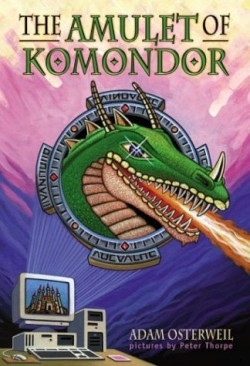The Amulet of Komondor
The linguistic fun starts with the title and ripples through this fast-paced adventure for middle- and high-schoolers until their parents start swiping the book for their own enjoyment. Keep a dictionary handy to get the most pleasure from this story.
Written by a junior high English teacher from New York, who is clearly hip to teens’ interest in computer and card games and Japanese-animated characters, the book is based on a premise that is deceptively familiar. Joe and his girlfriend, Katie, are obsessed with video games and bored with school, especially Mr. O’s English class (ah, the author injects himself into the plot within the first few pages). Joe is in trouble for not doing his homework, and his brainy, distracted parents are annoyed with his failures and caught up in their own project.
Not surprisingly, Joe and Katie break parental edicts, and find themselves cartoon characters in a Japanese computer game, fighting evil emperors and searching for the various pieces that go in the dragonhead amulet in order to save the day. The plot maneuvers as fast as the click of a mouse, and is made much more heady by the wordplay.
Who but a clever English teacher, who has studied the classics at Cornell University, could think of a way to make learning pronouns absolutely hilarious? The protagonists come to an old wooden bridge guarded by Bantam, a dwarf, and a big green troll named Guano, who doesn’t use pronouns when he speaks, which annoys the dwarf. Bantam says that Guano’s lack of personal hygiene, especially his teeth, scares people off. “There are no pieces of dwarfy stuck between teeth,” counters the troll, adding that his dentist “show Guano funny trick to keep teeth clean, but Guano forgot what trick called.” When Joe and Katie get to the bridge, Guano says, “None shall floss,” thereby remembering the name of the dental trick.
Dictionaries are as much a part of the action as spell books. At one point Katie asks a golem why he knows so many big words but doesn’t study grammar. “My grammar lives in the Peaks of Doom,” he says.
The illustrator, who has designed covers for Tony Hillerman mysteries and Garrison Keillor’s Lake Wobegone Days, uses the style of illustrations found in Japanese fantasy games to show how the characters look as they move back and forth across the computer screen like a modern-day Alice.
The author brings the high-speed chase of a plot to a literally warm-and-fuzzy conclusion, which reminds readers to pay attention to word meanings, including those in the title.
Reviewed by
Linda Salisbury
Disclosure: This article is not an endorsement, but a review. The publisher of this book provided free copies of the book to have their book reviewed by a professional reviewer. No fee was paid by the publisher for this review. Foreword Reviews only recommends books that we love. Foreword Magazine, Inc. is disclosing this in accordance with the Federal Trade Commission’s 16 CFR, Part 255.

